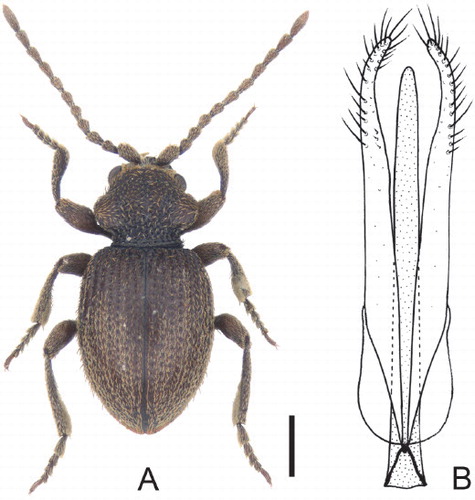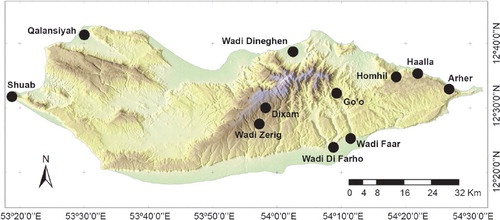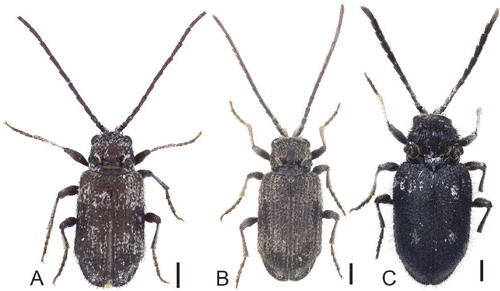Abstract
The previously known spider beetle fauna of Socotra comprises four endemic species (Mezium erinaceus Belles, Sphaericus hirsutus Belles, Ptinus bertranpetiti Belles, and Silisoptinus inermicollis Belles) and Dignomus mesopotamicus (Pic), which is also known from Arabia and Mesopotamia. The study of new material has resulted in the discovery of a new genus and two new species, and many new localities of the previously known species. Here, a synopsis is presented that brings together all information available on the fauna of spider beetles of the Socotra archipelago, including updated distributions and ecological and biogeographical considerations of all species.
http://www.zoobank.org/urn:lsid:zoobank.org:pub:3EB99992-B352-42AD-A33D-C01EF494666C
Introduction
The first data on spider beetles (Coleoptera: Ptinidae) from the Socotra Archipelago was reported in 2005, with the description of the species Silisoptinus inermicollis Belles, from Qalansiyah, in the main island of Socotra (Belles, Citation2005). Since then, the species Mezium erinaceus Belles, Sphaericus hirsutus Belles, and Ptinus bertranpetiti Belles have been described (Belles, Citation2009, Citation2012), and new localities of Dignomus mesopotamicus (Pic), have been reported (Borowski, Citation2002; Belles, Citation2009).
Recently, I received from Jiří Hájek a series of 65 spider beetles from Socotra deposited in the collections of the National Museum of Prague. The study of these new materials has resulted in the discovery of a new genus and two new species that are described in the present paper. In addition, the study has led to more details on the distribution area of several previously known species. This paper brings together all known information on the spider beetles fauna of Socotra Archipelago, including a number of ecological and biogeographical considerations regarding the species recorded.
Material and Methods
The new material of spider beetles examined in the present work consisted of six specimens from Socotra collected by Aidas Saldaitis in 2010, and 59 specimens collected during the three latest Czech expeditions of 2010 and 2012, described in detail by Bezděk and Hájek (Citation2017). The participants and insect collectors of these expeditions were Vladimír Hula and Jana Niedobová (in July 2010); Jan Batelka, Jan Bezděk, Jiří Hájek, Peter Hlaváč, and Luboš Purchart (in November 2010); and J. Bezděk, J. Hájek, V.Hula, Petr Kment, Igor Malenovský, J. Niedobová, and L. Purchart (in 2012) (Bezděk and Hájek, Citation2017). The specimens are deposited in The National Museum, Prague (NMPC), with some duplicates also in the collection of the author (XBC). The material commented herein also includes 82 specimens from Socotra previously reported by the author (Belles, Citation2005, Citation2009, Citation2012). These specimens had been collected by Antonius van Harten and Hans Pohl during two fieldtrips to Socotra in 1999 and 2000 (materials in the Hessisches Landesmuseum, Darmstadt, Germany, HLMD, and XBC), and by Vladimír Bejček and Karel St’astný in two fieldtrips in 2000 and 2001 (materials in the NNPC and XBC) (see Bezděk and Hájek, Citation2017, for an account on these expeditions). Therefore, the present synopsis is based on 147 specimens of spider beetles from Socotra Archipelago. In addition, I also studied abundant reference material of Ptinus, Niptus, Tipnus, Pseudeurostus, Niptodes, and related genera from different geographical origins, which were mainly from the collection of the author (XBC), and from the Maurice Pic collection that is preserved at the Muséum National d’Histoire Naturelle, Paris (MNHN).
Photographs of the specimens were taken with a Leica DFC 420 camera attached to a Leica M 80 binocular microscope, using the Combine ZP Image Stacking Software, by Alan Hadley (https://combinezp.software.informer.com). The aedeagus described in this paper was mounted in DMHF (dimethyl hydantoin formaldehyde resin) on a clear celluloid label pinned under the specimen, and drawn by hand with the help of a Nikon Optiphot microscope.
The locality names of the original labels of the specimens were assessed according to the toponyms checked by Bezděk et al. (Citation2012), and the later were used to establish the distribution maps.
Results
Mezium erinaceus Belles, 2009
Mezium errinaceus (sic) Belles. – Zahradník (Citation2015).
Material. The species was described from Dixam (“Diksam” in the original insect labels) and Go’o (“Goeeh”), on the basis of five specimens collected in 1999 and 2000 by A. van Harten and
H. Pohl. The new material consists of 27 specimens collected during the Czech expedition of 2012 (see Bezděk & Hájek, Citation2017), distributed as follows. Fifteen specimens: “Socotra Island, Dixam plateau, Firmihin, Dracaena woodland (sifting), 12°28.6’N, 54°01.1’E, 490 m, 14.-15.vi.2012 / Socotra expedition 2012, J. Bezděk, J. Hájek, V. Hula, P. Kment, I. Malenovský, J. Niedobová & L. Purchart leg. (NMPC)”; twelve specimens: “Socotra Island, Homhil protected area, open woodland with Boswellia & Dracaena trees (sifting), 12°34.5’N, 54°18.5’E, 360-500 m, 10.-11.vi.2012 / Socotra expedition 2012: J. Bezděk, J. Hájek, V. Hula, P. Kment, I. Malenovský, J. Niedobová & L. Purchart leg. (NMPC)”.
Endemic to Socotra, this Mezium is related to those distributed in the Mediterranean area, including North Africa (Belles, Citation2009). The new material indicates that the distribution of M. erinaceus is scattered throughout the eastern half of the island, in low woodland localities, at altitudes between 240 m (Go’o) and ca. 500–900 m (Homhil, Dixam) (), in some areas with Boswellia and Dracaena trees. The fact that most of the specimens have been collected by sifting suggests that M. erinaceus lives in forest leaf litter.
Figure 1. Distribution of Mezium erinaceus Belles (black squares), Sphaericus hirsutus Belles (black circle), Soqotranus niptoides sp. n. (white circle), and Ptinus bertranpetiti (white squares) in Socotra. The four species are Socotran endemisms.
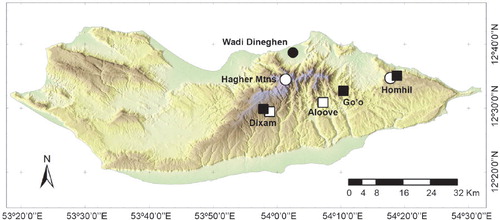
Sphaericus hirsutus Belles, 2009
Sphaericus hirsutus Belles, Citation2009. – Zahradník (Citation2015).
Material. Sphaericus hirsutus was described from Wadi Dineghen (“Wadi Danegan”), on the basis of 2 specimens collected in 2000 by A. van Harten and H. Pohl. Those are the only known specimens.
Endemic to Socotra, this Sphaericus is related to those of Canary Islands, especially to S. gibbicollis Wollaston (Belles, Citation2009). The type specimens were collected in Wadi Dineghen at low altitude (90 m) (), using barber pitfall traps. This suggests that S. hirsutus is a ground-dwelling species.
Soqotranus gen. n.
Type species. Soqotranus niptoides sp. n.
Description. Small, 2–3 mm. General habitus globose in both sexes; pubescence consisting of golden setae, distributed in all body parts (A). Head partially visible from above; eye round and convex, projecting laterally; interantennal space narrow, forming a sharp keel; antenna 11-segmented, filiform; last segment of maxillary and labial palpi fusiform. Pronotum granulose, with respective very apparent lateral prominences, and constricted in posterior quarter, showing a clearly delimited transversal groove; scutellum triangular, small but very apparent (A); prosternal process narrow, slightly extending past posterior margin of procoxae; mesosternal process short, not extending posteriorly beyond mesocoxae; legs with femur progressively widened distally, tibiae slender, tarsi with five tarsomeres in all legs. Elytra oval with humeral angles broadly rounded but still prominent, and longitudinally aligned rows of small punctures; pubescence composed of setae inserted along puncture rows and in the intervals (A). Abdomen with five visible ventrites, first of a length equivalent to a fifth of all segments, second almost twice as long as first, third and fifth only slightly longer than first, fourth the shortest of all, approximately half as long than third or fifth. Aedeagus simple, elongate and subsymmetrical (B); male genital segment composed of two simple branches. Sexual dimorphism slight, females are somewhat more robust than males.
Differential diagnosis. The new genus is distinguished by a set of characters, such as convex and prominent eyes, narrow interantennal space, pronotum with respective lateral prominences and clearly constricted in the posterior quarter, femora progressively widened distally, and very apparent scutellum. The head, with convex eyes and the interantennal space narrow, and the pronotum clearly constricted posteriorly, are reminiscent of the genus Ptinus L. For example, the structure of the head and pronotum is similar to that of Ptinus spitzyi Villa & Villa, known from central and southern Europe (Pic, 1912). However, the species of Ptinus s. str. are sexually dimorphic, the males having elongated and subparallel elytra, whereas they are shorter and oval shaped in the females. On the other hand, the oval shape of the elytra in both sexes is similar to that seen in species of the genus Niptus Boieldieu, which is practically cosmopolitan (Reitter, Citation1884; Pic, 1912). However, the species of Niptus s. l. have slightly convex eyes, interantennal space relatively wide and flat, pronotum without large lateral prominences, and femora sharply widened in the distal part. The general appearance of Soqotranus also resembles that of the genera Tipnus Thomson (distributed in Europe and North America), and Pseudeurostus von Heyden (distributed in Europe, Japan and North America). However, the species of these two genera have a different pronotum, without lateral prominences and with less pronounced posterior constriction, and the scutellum is either invisible (Tipnus) or it is very small and transverse, appearing to be part of the anterior border of the elytra (Pseudeurostus). Finally, Niptodes Reitter (=Microptinus Kiesenwetter, by homonymy) and the subgenera Paraniptus Kiesenwetter and Pseudoniptus Reitter (Reitter, Citation1884; Pic, 1912; Zahradník & Háva, Citation2014) might also be related to Soqotranus because both sexes have oval elytra. However, the species of these groups, among other minor differences, have the eyes smaller and less convex, the pronotum simple, without lateral prominences, and the elytra without humeral angles.
Distribution. Endemic to Socotra island ().
Etymology. The generic name refers to the gentilic of Socotra, using the Arabic transliteration “Soqotra”.
Soqotranus niptoides sp. n.
Material. Holotypus: Male, “YEMEN, Socotra Island, Al Haghier Mts. / Scant Mt. env., 12°34.6’N, 54°01.5’E, 1450 m, J. Bezděk leg. 12-13.xi.2010” (MNPC). – Paratypes: A female with the same data as the holotype (XBC). A male from “Socotra Island, Al Haghier Mts. [sifting], Scant Mt. env. 1450 m, 12°34.6’N, 54°01.5’E, 12-13.xi.2010, P. Hlaváč leg.” (MNPC). A female from “Socotra Isl., Hagher Mts., Skant, N 12°34,557’, E 054°01.514’, 7.-8.vi.2010, V. Hula & J. Niedobová leg” (MNPC). Nine specimens both sexes from “Socotra Island, Hagher Mts., Scand Mt. Env., montane evergreen woodland, 16.-18.vi.2012, 12°34.6’N, 54°01.5’E, 1450 m / Socotra expedition 2012: J. Bezděk, J. Hájek, V. Hula, P. Kment, I. Malenovský, J. Niedobová & L. Purchart leg. (NMPC and XBC)”. A male from “Socotra Island, Homhil protected area, open woodland with Boswellia & Dracaena trees, 10.-11.vi.2012, 12°34.5’N, 54°18.5’E, 360-500 m / Socotra expedition 2012: J. Bezděk, J. Hájek, V. Hula, P. Kment, I. Malenovský, J. Niedobová & L. Purchart leg.“ (NMPC).
Description. 1.9-3.1 mm long. Globose in both sexes, generally brown. Head partially visible from above; surface with scattered erect golden setae; eyes round and slightly convex, projecting laterally; antenna filiform but robust, slightly shorter than body length; first segment large and robust, second more graceful and half as long as the first, from second to tenth progressively increasing in length, last the longest of all (A). Pronotum with granulations convex and well delimited, except in the anterior part, which is smoother and with two thin transverse grooves, with two prominent, subconical lateral lobes, and with the posterior constriction consisting of a well delimited wide transverse groove wide and also covered with granulations; scutellum small and forming an equilateral triangle (A); legs slender, tarsi with five tarsomeres, first one a quarter as long as the entire tarsi, second, third and fourth progressively decreasing in length, fourth approximately the same length as first. Elytra with longitudinally aligned rows of small, rounded punctures, slightly smaller than intervals; pubescence composed of golden setae, short and recumbent, inserted in the punctures, and similar but longer setae, recumbent, inserted in the intervals. Aedeagus elongate, subsymmetrical, parameres longer than median lobe, with a series of long erect setae inserted in the apical region and in the anterior third of the external part of each paramere (B). Sexual dimorphism slight, females have antennal segments slightly shorter, eye somewhat smaller and elytra slightly more convex than males.
Differential diagnosis. Soqotranus niptoides is the only species of the genus, and can be distinguished from other spider beetle species according to the differential diagnosis of Soqotranus (see above).
Distribution. Known from 13 specimens from the typical locality, in the vicinity of Peak Scant, the highest in Socotra, reaching 1,526 m, as well as from a specimen from the Homhil protected area (open woodland with Boswellia & Dracaena trees), at 360– 500 m ().
Biology. Species found in montane evergreen woodland, in slight to mid elevation, between ca. 300 and 1500 m. A series of specimens were collected by sifting, which suggests that it lives in forest litter.
Etymology. The specific name refers to the general similarity with the species of Niptus.
Ptinus bertranpetiti Belles, 2012
Ptinus bertranpetiti Belles. – Zahradník (Citation2015).
Material. Ptinus bertranpetiti was described with a specimen from Dixam plateau (H. Pohl campaign of 1999) and two specimens from “Zemhon area, 270-350 m 12°30′58″N 54°06′39″E” (Czech expedition, 2010), which corresponds to Aloove village in the center-east of the island (Bezděk et al., Citation2012). These three specimens are the only known material.
Endemic to Socotra, P. bertranpetiti is related to the Palearctic Ptinus belonging to the subgenus Gynopterus (Iablokoff-Khnzorian & Karapetian, Citation1991; Belles, Citation2012). It would be localized in medium to relatively high altitude localities (250–1000 m) in the central part of the island (). Nothing is known about the biology of this rare species.
Dignomus mesopotamicus (Pic, Citation1894)
Ptinus pulverulentus v. mesopotamicus Pic, Citation1894.
Ptinus (Pseudeutaphrus) pulverulentus v. mesopotamicus, Pic. – Pic (1912).
Dignomus pulverulentus (Boieldieu). – Belles (Citation1996).
Dignomus mesopotamicus (Pic). – Borowski (Citation2002), Belles (Citation2009), Zahradník (2012).
Material. I previously examined 73 specimens of D. mesopotamicus from the following Socotran localities (Belles, Citation2009): Wadi di Farho (“Nogeed, Farmihin”, “Nogeed, Farmihin, Steroh, Wadi”), close to the beach, 0 m; Dixam (“Deksam”) Plateau, wetlands of little creek, 1020 m, Malaise trap; Homhil, spring with Ficus, light trap; Wadi Dineghen (“Wadi Danegan”), 90 m; Haalla (“Halle”), coastal road close to the shore, granite/sandstone, Malaise trap; Go’o (“Goeeh”), 240 m; Qalansiyah (“Calanthia”); Noged; Shuab (“Shoab”); Wadi Faar; and Wadi Zerig (“Zerik”); Abd al-Kuri Island (anchorage place, Malaise trap). Additionally, I have studied now a male specimen collected during the Czech expedition of 2012 (see Bezděk & Hájek, Citation2017) in the Haalla area: “Socotra Island, Halla area, Arher, freshwater spring in sand dune, 9-10. + 15.vi.2012/ 12°33.0’N, 54°27.6’E, 5 m / Socotra expedition 2012, J. Bezděk, J. Hájek, V. Hula, P. Kment, I. Malenovský, J. Niedobová & L. Purchant leg.”.
Dignomus mesopotamicus is known from Arabia and Mesopotamia (Pic, 1912), including the Socotra Archipelago (Borowski, Citation2002; Belles, Citation2009). It belongs to the “Dignomus pulverulentus group” as defined by Belles (Citation1996), whose species are distributed on both sides of the Red Sea, reaching the Iranian plateau in the east. The data indicate that D. mesopotamicus is widely distributed throughout most of the island of Socotra (), being present also in the small adjacent island of Abd al Kuri. It seems to be an ecologically versatile species, which lives from coastal dunes areas (0 m), to mid-mountain places, such as Homhil (300–600 m), and wetlands in the Dixam plateau (1020 m). In Homhil, it was collected near a stream with Ficus via light traps. In Haalla and Abd al Kuri, it was captured with Malaise traps. These data suggest that D. mesopotamicus is an efficient flier, which may have facilitated the colonization of Abd el Kuri from Socotra, and even of Socotra from the Arabian mainland.
Silisoptinus inermicollis Belles, 2005
Silisoptinus inermicollis Belles, Citation2005. – Belles (Citation2009), Zahradník (Citation2015).
Material. Silisoptinus inermicollis was described with a male specimen collected at Qalansiyah (“Calanthia”), a coastal locality (5–15 m) in the northwest of the island (). Now, I have studied six new specimens collected by A. Saldaitis in 2010, and 14 specimens from the Czech expeditions of 2010 and 2012 (Bezděk & Hájek, Citation2017). These 20 new specimens are from the following localities. One from: “Coll. I.R.Sc.N.B., Sokotra Island N, Di Hamri env., 01-III-2008 – I.G.31.496, Leg. A. Saldaitis”; one from: “Coll. I.R.Sc.N.B., N. Sokotra isl., Ayheft valley, 20-I-2010, Leg A. Saldaitis, Achat Saldaitis. I.G.31.512” (“Ayheft valley” corresponds to Wadi Ayhaft); four from: “Coll. I.R.Sc.N.B., N. Sokotra isl., Near Hadibu, 11-I-2010, Leg A. Saldaitis, Achat Saldaitis. I.G.31.512” (“Hadibu” corresponds to Hadiboh); four from: “Socotra Island, Zemhon area, 270-300 m, N 12°20’58’’, E54°06’39’’, 16.-17.6.2010, V. Hula leg” (this locality corresponds to Aloove, see Bezděk et al., Citation2012); eight from: “Socotra Island, Aloove area, Aloove vill. env., Jatropha unicostata shrubland with Boswellia elongata trees, 12°31.2’N, 54°07.4’E, 221 m, 19.-20.vi.2012 / SOCOTRA expedition 2012: J. Bezděk, J. Hájek, V. Hula, P. Kment, I. Malenovský, J. Niedobová & L. Purchart leg. (NMPC)”; one from: “Socotra Island, Kaza Kazihon vill. env., 12°31’13″N, 53°55’36″E, 900 m, 5.vi.2012, V. Hula & J. Niedobová leg. (NMPC)”; one from: “Socotra Island, Kesa env., 12°39’37″N, 53°26’42″E, 220-300 m, 28.-29.i.2010, L. Purchart leg. (NMPC)” (“Kesa” corresponds to Qeysoh).
Figure 4. Distribution of Silisoptinus inermicollis Belles (black circles), and Silisoptinus hajeki sp. n. (white circle) in Socotra. The two species are endemic to Socotra.
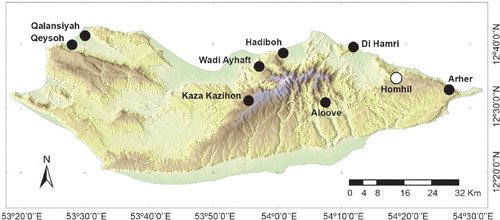
Endemic to Socotra, S. inermicollis is the second species of the genus Silisoptinus, after Silisoptinus singularicollis Pic, known from Zanzibar, in continental Africa (Pic, Citation1917). The new localities extend the distribution of S. inermicollis throughout the northern half of the island, predominating in coastal localities, such as Qalansiyah (5–15 m), Qeysoh (35 m), Di Hamri (6 m), Hadiboh (10-20 m), Wadi Ayhaf (40 m, in the lower part of the valley) (). Moreover, S. inermicollis also spreads in the central area of the island, at altitudes between 300 m (Aloove), and ca. 900 m (Kaza Kazihon, at 890 m) (Bezděk et al., Citation2012) (). Although it is not as generalist as D. mesopotamicus, S. inermicollis seems remarkably versatile from an ecological point of view, spreading in coastal habitats, in dune areas, also in the lower river basins, and in slight to mid elevation areas, such as the locality of Aloove, with predominance of Jatropha unicostata shrubland with Boswellia elongata trees.
The specimens from the northern, coastal zone correspond morphologically to the holotype specimen, in particular with regard to elytral pubescence. As in the holotype, all have an elytral pubescence of three types: 1: long, brownish hairs, erect and placed on the intervals; 2: short, brownish-yellow hairs, recumbent and placed in the punctures, and 3: recumbent and dense short pale hairs scattered over anterior third and behind disc (see A, showing the holotype, which exemplifies this kind of pubescence). The Aloove and Kaza Kazihon specimens do not clearly show the third type of pubescence that in other localities form discrete spots, but is sparser and more or less distributed throughout the elytron (B). However, the general morphology and the structure of the aedeagus conforms to that of the holotype of S. inermicollis, thus the detail of the virtual absence of well-defined spots of recumbent pale hairs should be considered within the range of variability of the species. Until now, only a male of S. inermicollis was known (Belles, Citation2005, Citation2009), therefore, the availability of females now makes it possible to assess that sexual dimorphism is minimal. Females are a bit more robust than males, in general, with the posterior third of the elytra slightly more convex, and the eyes somewhat less prominent.
Silisoptinus hajeki sp. n.
Material. Holotypus: Female, YEMEN “Socotra Island, Homhil protected area, open woodland with Boswellia & Dracaena trees; 10.-11.vi.2012 / 12°34.5’N, 54°18.5’E, 360-500 m / Socotra expedition 2012, J. Bezděk, J. Hájek, V. Hula, P. Kment, I. Malenovský, J. Niedobová & L. Purchant leg.”.
Description. Female (C) 4.6 mm long. Robust, subparallel sided; cuticle blackish. Head densely clothed with fine, short, white, recumbent hairs, and a number of scattered blackish hairs, erect, projecting towards the front; eyes round and moderately convex, antennae filiform, slender, slightly shorter than body length, the first segment, large and robust, second half as long as first, from second to eleven, progressively increasing in length. Pronotum with the disc deeply excavated in posterior third, disc convex and with numerous longitudinal grooves, basal third with a deep transverse groove and with elliptic, spiral shaped structure at each side, which is very sclerotized and has a dense patch of yellowish tomentum on upper part; pronotal disc showing fine, short, yellowish recumbent hairs, and long blackish hairs, erect, projecting towards the head; scutellum triangular, longer than wide; legs slender, tarsi with five tarsomeres, the first one almost a quarter as long as the entire tarsi, second, third and fourth progressively decreasing in length, fourth approximately the same length as first (the tarsi of the three right legs are missing in this specimen: C). Elytra subparallel-sided, with apical third quite pointed and humeral angles broadly rounded; basal quarter showing a series of fine grooves starting from the scutellum and diverging to the elytral sides; punctures not very marked, confused by the generally rough surface of the elytra, especially on the disc, which is very convex; pubescence of three types: 1st) very long, blackish hairs, erect and placed on the intervals, 2nd) short, brownish hairs, recumbent and placed in the punctures, and 3rd) recumbent and dense short pale hairs forming a discontinuous band in the basal quarter, and two discrete spots behind disc (C). Male unknown.
Differential diagnosis. The shape of the pronotum of S. hajeki is reminiscent of that of S. inermicollis Belles (Belles, Citation2005, Citation2009). In contrast, the pronotum of S. hajeki is very different from the other species of the genus, S. singularicollis Pic, from Zanzibar, in the Indian Ocean, off the coast of Tanzania (Pic, Citation1917). S. hajeki can be readily distinguished from S. inermicollis by having the following differentiating characters. The larger size of S. hajeki (4.6 mm) compared with S. inermicollis (2.9-4.3 mm); the scattered long and erect blackish hairs of the head (whitish and shorter in S. inermicollis); the relatively short antennae, which are shorter than body length (longer than body length in S. inermicollis); the prominent elliptic, spiral shaped structure at each side near the pronotum base (less prominent in S. inermicollis); the long and erect blackish hairs of the pronotum (absent in S. inermicollis); the elytra with the apical third quite pointed, the humeral angles broadly rounded, and the disc very convex (elytra with the apical third rounded, somewhat depressed at the apex border forming a convex rim, humeral angles prominent, and the disc practically flat in S. inermicollis); the elytra showing a series of fine grooves at the base, and the punctures not very marked and confused by the generally rough surface of the elytra (elytra without striations at the base, and with the punctures well marked, forming well defined longitudinal puncture lines and intervals in S. inermicollis); the elytral pubescence showing a type of recumbent and dense short white hairs that form a discontinuous band in the basal quarter, and two discrete spots behind disc (in S. inermicollis this type of white pubescence is scattered over anterior third and behind disc, and at the apex, and can be even absent, especially in the specimens from Aloove and Kaza Kazihon).
Distribution. Silisoptinus hajeki is endemic to Socotra, localized in the Homhil basin, in the northeast of the island ().
Biology. The only specimen was collected in an area with open woodland with Boswellia elongata, and Dracaena cinnabari trees (Bezděk et al, Citation2012).
Etymology. Dedicated to my friend and colleague Jiří Hájek, one of the collectors of the holotype, who sent it to me for study, and who already guessed that it was a new species.
Discussion
The new material of spider beetles from the island of Socotra has led to the identification of a new genus and species, Soqotranus niptoides, and a new species of the genus Silisoptinus, S. hajeki. In addition, the distribution of the other known species has been considerably expanded, in particular that of S. inermicollis, until now known only from the locality of Qalansiyah, and at present showing a distribution that includes eight localities distributed throughout most of the island. With these data and those of previous contributions (Belles, Citation2005, Citation2009, Citation2012), the representation of spider beetles from the Socotra archipelago consists of six genera, one of them endemic, and seven species, six of which endemic.
It is clear that the spider beetle fauna of an island as diverse in biotopes as Socotra, and with limited explorations, is not completely known, in qualitative and quantitative terms. However, a total of 147 specimens collected in 18 fairly representative localities justifies a number of provisional conclusions. Data indicate, for example, that not all species are equally represented in the samples (). Silisoptinus hirsutus, P. bertranpetiti, and S. hajeki are rare and more or less localized, S. niptoides is relatively abundant but narrowly localized, and S. inermicollis and especially D. mesopotamicus are quite abundant and widely distributed. From a biogeographical point of view, data suggest that the affinities of the Socotran endemic spider beetles are diverse. There are species clearly related to North African faunas, such as M. erinaceus and S. hirsutus (see Belles, Citation2009), others with rather Palearctic or Holarctic affinities, such as P. bertranpetiti (Belles, Citation2012) and S. niptoides, respectively, while the two Silisoptinus species would come from East African lineages (Belles, Citation2009).
Table 1. Abundance and altitudinal occurrence of spider beetles in Socotra Island. Indicated for each are the number of specimens examined, the number of collecting localities and the altitude, which is classified into three main categories: “Sea level” (coastal areas), “Mid altitudes” (250– 900 m) and “High altitudes” (>900 m). All species are endemic to Socotra archipelago, except D. mesopotamicus. All localities refer to Socotra Island, except in those of D. mesopotamicus which include also a record of Abd al Kuri.
Acknowledgements
The new material studied (Saldaitis fieldtrip of 2010, and the three Czech expeditions of 2010 and 2012) was provided to me by Jiří Hájek (Department of Entomology, The National Museum, Prague, Czechia). Those previously studied from the 1999 and 2000 fieldtrips of A. van Harten and H. Pohl were provided to me by Robert Güsten (Hessisches Landesmuseum, Darmstadt, Germany), whereas those from the 2000 and 2001 fieldtrips of V. Bejček and K. St’astný, were sent to me by Petr Zahradník (Forestry and Game Management Research Institute, JilovisteStrnady, Prague, Czechia). I thank those colleagues and institutions for entrusting me with the study of their materials. Thanks are also due to Jéan Ménier and Thierry Deuve (Muséum national d’Histoire naturelle, Paris, France), for making the spider beetles from the collection of Maurice Pic accessible to me on many occasions, and to Txus Gomez-Zurita for taking the photographs of the species shown in the present work. Jan Bezděk provided me with the Socotra maps that I have used in this article. Finally, I appreciate the comments of two anonymous reviewers who helped improve the manuscript.
Disclosure Statement
No potential conflict of interest was reported by the author.
Additional information
Funding
References
- Belles, X. (1996). El género Dignomus Wollaston (Coleoptera, Ptinidae). Bolletí de la Societat d’Història Natural de Balears, 39, 209-228.
- Belles, X. (2005). A synopsis of the genus Silisoptinus (Pic, 1917) (Coleoptera, Ptinidae), with the description of a new species from Socotra Island. Elytron, 19, 77–82.
- Belles, X. (2009). Spider beetles (Coleoptera, Ptinidae) from the Socotra Archipelago. Fauna of Arabia, 24, 145–154.
- Belles, X. (2012). Ptinus bertranpetiti, a new species of spider beetle from Socotra Island (Coleoptera: Ptinidae). Acta Entomologica Musei Nationalis Pragae, 52 (Supplementum), 219– 222.
- Bezděk, J., & Hájek, J. (2017). Insect biodiversity of the Socotra Archipelago – underlined and counted. Acta Entomologica Musei Nationalis Pragae, 57 (Supplementum 2), 1–39. doi: 10.1515/aemnp-2017-0105
- Bezděk, J., Purchart, L., Král, K., & Hula, V. (2012). List of local Socotran geographical names used in entomological literature. Acta Entomologica Musei Nationalis Pragae, 52 (Supplementum), 27–67.
- Borowski, J. (2002). A world catalogue of the genus Dignomus Wollaston. Annals of the Warsaw Agricultural University, Forest and Wood Technology, 52, 35–40.
- Hájek, J., & Bezděk, J. (2019). Annotated catalogue of beetles (Coleoptera) of the Socotra Archipelago. Zootaxa, 4715, 1–76. doi: 10.11646/zootaxa.4715.1.1
- Iablokoff-Khnzorian, S. E. M., & Karapetian, A. P. (1991). Ptinus-Studien (Coleoptera, Ptinidae). Entomologische Blätter, 87, 1–65.
- Pic, M. (1894). Descriptions et notes entomològiques (Coléoptères). L’Échange, 113, 66. Pic, M. (1912). Ptinidae. Coleopterorum Catalogus, 41, 1–46.
- Pic, M. (1917). Descriptions abrégées diverses. Mélanges exotico-entomologiques, 24, 2–24.
- Reitter, E. (1884). Bestimmungs-Tabellen der Europaischen Coleopteren, 11, Bruchidae (Ptinidae). Verhandlungen des naturforschenden Vereines in Brünn, 22, 295–323.
- Zahradník, P. (2015). A review of Ptinidae (Coleoptera: Bostrichoidea) of Socotra Island. Studies and Reports, Taxonomical Series, 11, 197–220.
- Zahradník, P., & Háva, J. (2014). Catalogue of the world genera and subgenera of the superfamilies Derodontoidea and Bostrichoidea (Coleoptera: Derodontiformia, Bostrichiformia). Zootaxa, 3754, 301–352. doi: 10.11646/zootaxa.3754.4.1

